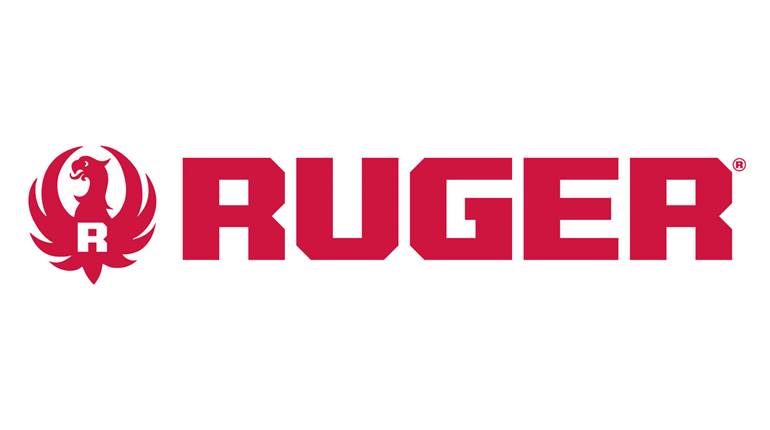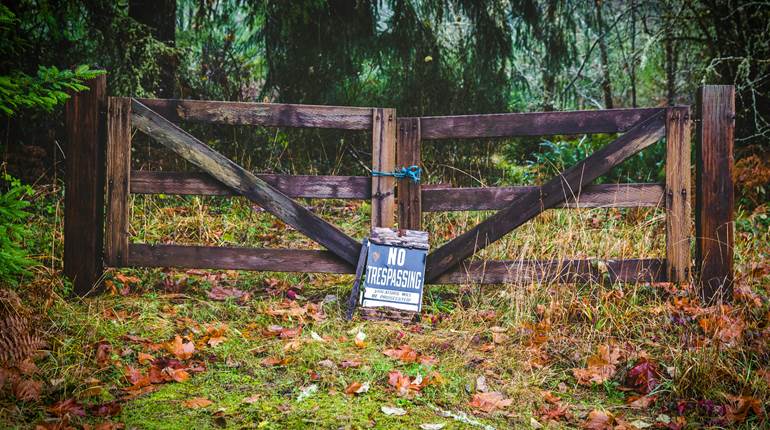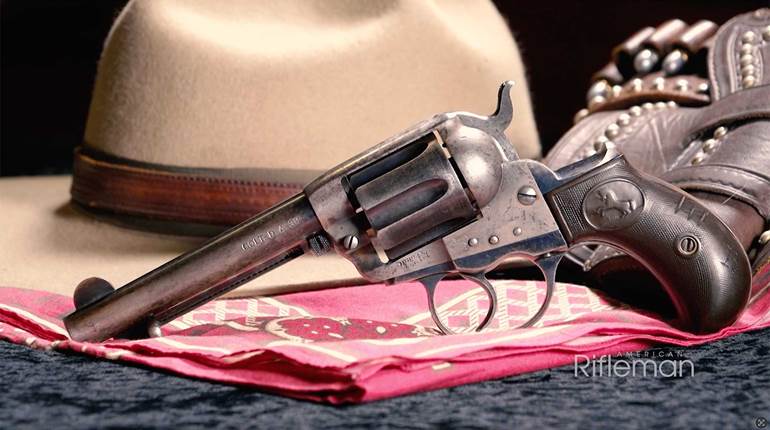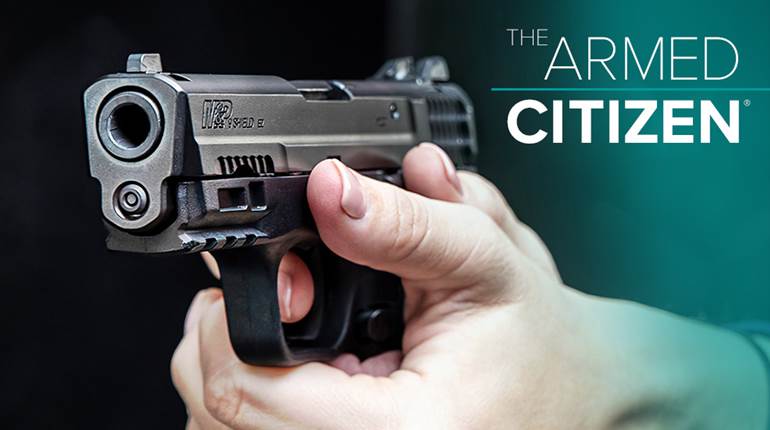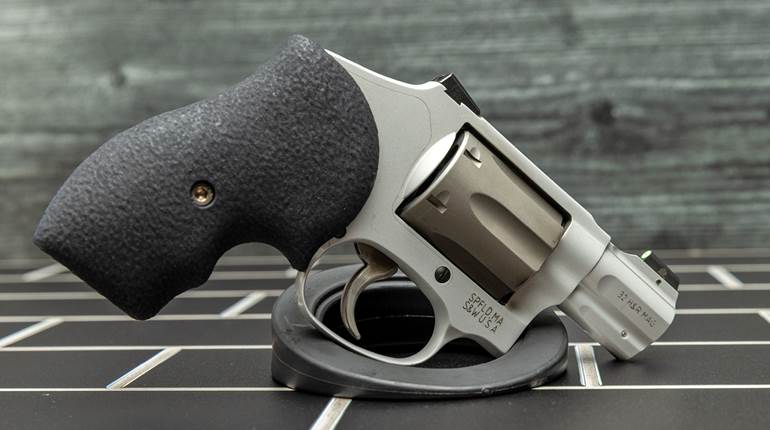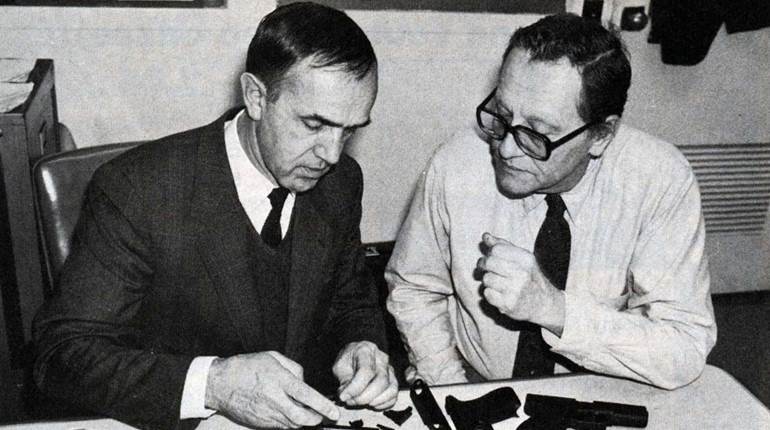
Burris forever changed big-game rifle hunting with the debut of the Eliminator riflescope in 2010. How? Instead of the time-consuming process of ranging the distance to the target followed by dialing up the elevation turret, or the improvised and imprecise “holdover,” the Eliminator calculated the exact distance and angle to the hunter’s quarry, then accounted for the cartridge’s external ballistics and finally provided an illuminated aiming point—almost instantaneously. By removing much of the guesswork from the equation, the optic increased the distance at which quality shots could be ethically taken.
While the aesthetically odd, yet innovative, Eliminator was groundbreaking in design, it was not faultless. Refinements to the platform were needed and have subsequently been applied throughout the next five generations of the design. The newest variant, the Eliminator 6, was introduced at the Shooting, Hunting and Outdoor Trade (SHOT) Show in 2024.
Past Into Present
Unlike its forerunners, the Eliminator 6 is the only one that resembles a traditional riflescope and takes advantage of the mounting flexibility that such a configuration accommodates. It’s also absent the unnecessary grim reaper logo, giving it a more serious appearance. Weighing 30 ozs., the matte-black aluminum optic measures 14.5" long and sports a 34 mm main tube spanning 6.63". A 3"-long sunshade and flip-up protective caps accompany the scope.
The objective lens is 52 mm and the diameter of the objective bell measures 60 mm, thereby necessitating higher scope rings. Speaking of rings, those in excess of 30 mm are often pricey; this is the only disadvantage of the Eliminator 6, as previous iterations could be mounted directly to Weaver- and Picatinny-style bases without using rings. The trade-offs, however, are worth the added expense. The ocular lens is 44.2 mm in diameter; multi-coated high-definition glass is utilized throughout.
A fast-focus eyepiece enables focusing of the reticle and heads-up display (HUD), while the side-focus parallax-adjustment knob—located on the optic’s left—adjusts from 25 yards out to infinity. It’s sufficiently tensioned to prevent unintended movement. So, too, is the magnification band, which can be fine-tuned between 4X and 20X; turning the band not only changes magnification, but also re-illuminates the HUD and restarts the HUD sleep timer. Aggressive cuts on the parallax-adjustment knob and magnification band improve purchase when adjusting those controls.
Removing the low-profile turret caps grants access to windage and elevation turrets for tweaking the point of impact. Valued at 1/8-m.o.a., the clicks are audible, tactile and positive. The total adjustment range for both the elevation and windage adjustments is 40 m.o.a.—slightly less than the Eliminator 5. There is a “0” notch on each dial that can be aligned with a zero line for simple return to zero. Once zeroed, a small, non-sharp object, such as a pen or toothpick, is needed to complete the chore. But, since the scope employs technology-aided trajectory compensation, I see no need for it. A QR code granting access to the Burris app is found inside of each turret cap. Smart move.
Three interface buttons are located on the outside of the parallax-adjustment dial. The largest and forward-most control powers on the unit, wakes it from sleep and determines the range. Pressing it for five seconds shows the currently uploaded ballistic profile. The rear buttons adjust reticle brightness—either automatically determined by the unit or via nine user-adjustable settings—and provide access to the density altitude (DA) override menu.
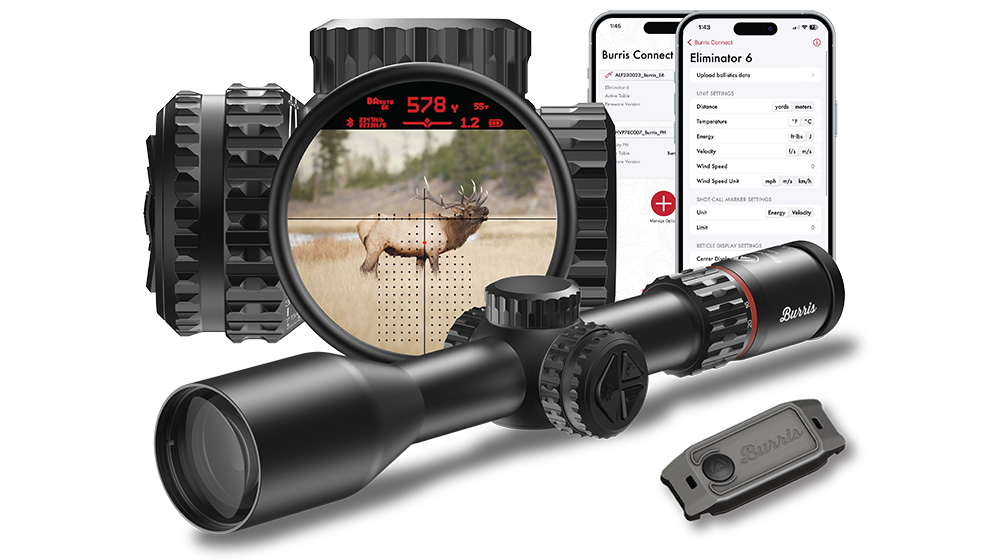
Powering the Eliminator 6 is a single CR123 battery, which is provided. Rechargeable batteries are incompatible with the circuitry and void the warranty. It’s recommended that the battery be removed for long-term storage—but don’t worry—stored scope data won’t be lost. You’ll need to download the BurrisConnect app to your smartphone to program the Eliminator 6, which requires a high-speed cellular or Wi-Fi connection. However, the app connects to the optic via Bluetooth, so an Internet connection isn’t required on the range or in the field.
The sixth-generation Eliminator doesn’t rely on a prebuilt library of data into which your cartridge fits; rather, you have access to the specifics of most factory cartridges, which can be amended, and specifications for handloads can be added, too—more on this later. BurrisConnect also permits the user to customize the HUD to fit his/her preferences. The default display reveals the distance to the target and scope level in the center, with the hold value for a standard 10-m.p.h., 90-degree wind (which can be adjusted in the app) shown to the right. Be aware that the illuminated aiming point doesn’t factor in the windage; however, dots are provided for you to determine the correct point of aim.
Also displayed is: battery status, DA and temperature using an onboard weather station, impact energy and travel velocity, and a shot call marker. The latter discloses whether the bullet has insufficient energy or velocity (for expansion), preventing the taking of ill-advised shots on game. How do you know? Simply stated, you’ll need to do research. Contact your state’s department of wildlife resources, or whatever its moniker is, and/or the projectile’s maker.
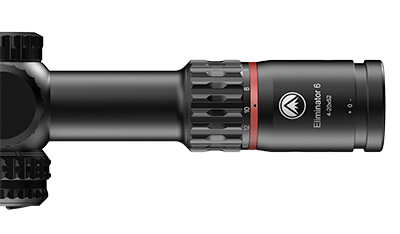
The setup process for the Burris Eliminator 6 is remarkably simple. Once the BurrisConnect app has been downloaded, the scope can be paired via Bluetooth. You’ll then be able to change the unit of measure (metric vs. imperial), shot call marker, reticle display (including timeout) and scope-leveling settings. These are transferred automatically to the scope.
Next, the user builds custom rifle and ammunition profiles. The factory ballistic data—muzzle velocity, bullet weight and G1 ballistic coefficient (BC)—of many popular loads is provided; however, customization (i.e. actual velocity) is recommended for the utmost accuracy. The BC can be changed to G7, too. Handloaders have access to an extensive library of component bullets, and selecting one automatically adds the BC and projectile weight to the profile; the user just needs to supply the velocity. Even shotguns (slugs) and muzzleloaders can be used with the Eliminator 6. The profile is then uploaded—rapidly, I might add—to the scope. When switching between loads, the new data will need to be transferred to the optic.
Once zeroed, and the proper bullet profile uploaded, the Eliminator 6 is ready for the field. The riflescope will range highly reflective targets out to 2,000 yards, and up to 1,800 yards on deer hide; however, that doesn’t mean a shot can—or should—be taken at those distances. Once the target is ranged (by pressing the front interface button or by using the included wireless remote switch), the scope’s X177 reticle, which includes 177 micro LEDs, provides an aiming solution with 1/6-m.o.a. accuracy. The reticle maintains its size throughout the magnification range, as in a second-focal-plane scope. It also adjusts the illuminated aiming point based on the current magnification.
The initial display, where all supplementary details pertinent to the shot are shown on the HUD, is preset to 15 seconds. The time for default extended display, where only essential information necessary for the actual shot is shown, is also 15 seconds, but both can be customized via the app. I highly recommend doing so; you don’t want the display to power down while waiting for the perfect shot. Know, however, that once it has been zeroed, the Eliminator 6 can be used like a traditional riflescope should the HUD go dark or the battery die. The optic will go into sleep mode after a predetermined period; it’s preprogrammed to do so after 10 minutes, but this, too, can be adjusted by the user.
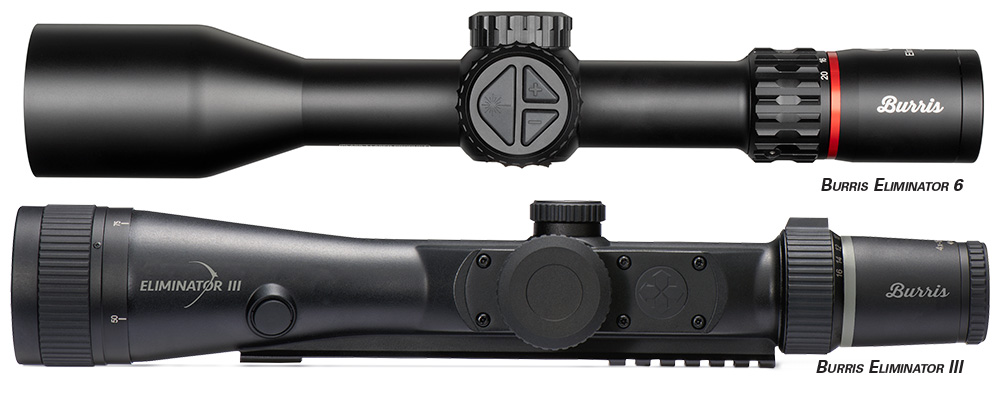
Evaluating The Eliminator 6
For testing, I affixed the sample Eliminator 6 atop a stately Savage Arms Model 12 fitted with a carbon-fiber-wrapped, 20", 1:8"-twist Proof Research barrel—a rifle proven to be a reliable performer—via two-piece mounts. Three .223 Rem. loads were selected to verify the scope’s trajectory-compensating aptitude. They were: Nosler Varmageddon 55-grain FB Tipped; Federal Premium Gold Medal Match Sierra 69-grain BTHP MatchKing; and a hand-load employing the Sierra 77-grain BTHP MatchKing. The exact profile for the former wasn’t located in Burris’ library, however, after consulting the Nosler website, it matched the velocity and G1 BC of a profile named “FBSP,” so that one was used. The actual velocity needed to be added anyway. I found the Federal Premium load in the scope’s database, and all information in the library matched that on the box. I then built a profile for the handload.
At the range, I uploaded the data for the Federal Premium load first. After zeroing the setup at 100 yards and shooting three, five-shot groups to determine an average dispersion rate, I then pushed the combination to the range’s maximum distance, 310 yards, to determine if the trajectory compensation was accurate. It was spot-on. I found that the center of two, five-shot groups was only 0.522" low from the point of aim, albeit 5.095" left due to the 10-m.p.h. wind with gusts that doubled that. Remember, the Eliminator 6 doesn’t compensate for wind deflection.
Next, I transferred the profile for the zippier Nosler Varmageddon load to the Eliminator 6, re-zeroed the rifle and replicated the previously mentioned confirmation process. It proved to be only 0.518" low of the target’s center. Finally, after adjusting the 100-yard zero for the handload and uploading the information to the optic, the 77-grain bullets were sent speeding downrange. The result: a group 0.276" lower than the target’s center. Thus, the variance between the point of aim and the center of 30 shots at 310 yards was 0.439"—impressive! What’s more, the ambient temperature determined by the onboard thermometer (and displayed in the HUD) matched that of weather apps for the area throughout the entire shooting session—ranging from 84° F to in excess of 90° F.
To verify the consistency and accuracy of the windage and elevation adjustments, I “shot the square” at 100 yards using the Nosler Varmageddon load. Three rotations—with 16 “clicks” in each direction—created four, three-shot groups measuring 0.275" to 0.664", forming a mostly symmetrical square. These results confirm that the scope’s adjustments were accurate and repeatable.
After an overnight stint in the refrigerator freezer, the sample scope was immediately submerged for a few minutes in a dishpan of warm water. As was expected, there was slight internal fogging—purging an optic doesn’t prevent that altogether—but it readily cleared, and the absence of bubbles indicated that it was free of leaks—both good things considering its intended use.
In side-by-side testing during varying light conditions and identical magnification settings, the quality of the Eliminator 6’s glass and coatings compared favorably to that of a competitor. That’s not surprising, though, as Burris notes on its website, “This is the best optical system ever used in an Eliminator.” I found the optic provided sharp, bright images with excellent resolving power. A nearby shooter, who was invited to use the scope, also noted its clarity.
With the Eliminator 6, Burris has proven that it’s not satiated with past successes. Improvements have led to the newest version of the optic being considerably more capable, accurate and user-friendly. For a seemingly complicated piece of kit, it’s also nearly foolproof—which was a wise choice on the company’s part. Hunters who want to focus less on trajectory compensation and more on executing a perfect shot should seriously consider investing in one.














